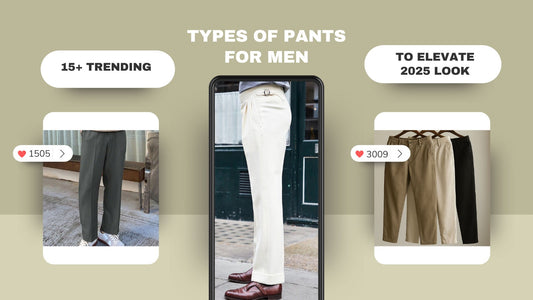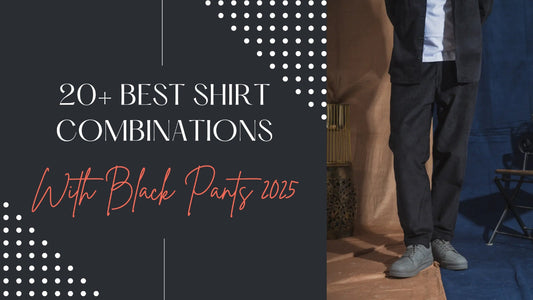Buying a T-shirt. A simple activity, until you're stuck choosing between a size M that hugs too tight or an XL that hangs like a curtain. To find the correct T-shirt size, whether you're shopping in-person or online, can be something of a challenge. And it's not just about the number on the tag, the comfort, styling, and how confident you feel wearing that t-shirt matters just as much.
Read this blog to learn everything you need to know about men’s T-shirt sizes. Let’s help you find the perfect fit without trial and error.
Why the Right T-Shirt Size Matters: Comfort, Confidence & Style
T-shirts are a wardrobe basic, but when it fits just right, it becomes a style essential. Here’s how size plays a role in how you look, feel, and move:
- Fitting (Aesthetic): A well-fitting T-shirt defines your body without overexposing or hiding too much. It adds structure and enhances your silhouette, whether you're lean, muscular, or somewhere in between.
- Styling (Confidence): When you know your T-shirt fits well, you automatically feel more confident. It complements your jeans, shorts, or even a casual blazer.
- Comfort (Wearing Experience): The right size ensures you’re not constantly tugging at sleeves or adjusting the hem. It allows easy movement and feels natural through the day, especially in India’s humid weather.
So yes, T-shirts may be basic, but choosing the right size is a smart style move.
What Are the T-Shirt Sizes for Men?
When it comes to buying a T-shirt, simply choosing between S, M, or L isn’t always enough. Understanding what these sizes mean in actual measurements can help you make a more confident and comfortable choice. Below is a breakdown of the most commonly available men’s T-shirt sizes and how they translate to chest and waist measurements (in inches):
Small (S)
- Chest: 36–38 inches
- Waist: 30–32 inches
This size is generally suited for men with a leaner build. If you have a slim frame and prefer a more fitted look without the shirt clinging to your body, small is likely the way to go. It's ideal for those who want their T-shirt to sit close to the body while still allowing enough room for comfort and movement.
Medium (M)
- Chest: 38–40 inches
- Waist: 32–34 inches
Medium is one of the most commonly worn sizes among men. It works well for average builds and provides a slightly relaxed yet flattering fit. If you're someone who likes a bit more breathing space in the chest and waist but doesn’t want to go too loose, medium can strike that perfect balance between fitted and comfortable.
Large (L)
- Chest: 40–42 inches
- Waist: 34–36 inches
Large is suitable for men with a broader upper body or those who prefer a roomier fit. If you hit the gym regularly or have a wider chest and shoulders, this size gives you space without making the T-shirt look oversized. It maintains a clean silhouette while offering ease of movement.
Extra Large (XL)
- Chest: 42–44 inches
- Waist: 36–38 inches
This size is meant for bigger builds or men who like a looser and more laid-back style. If you're someone with a broad frame or simply prefer your T-shirts not to cling too tightly, XL provides a relaxed fit that still looks put together.
Double Extra Large (XXL)
- Chest: 44–46 inches
- Waist: 38–40 inches
XXL is designed for those who want maximum room and comfort. It suits larger body types and is perfect for casual, loose-fitting styles. While it offers more space, it can still look stylish when paired with the right fit around the shoulders and sleeves.
|
Size |
Chest Measurement |
Waist Measurement |
|
Small |
36–38 inches |
30–32 inches |
|
Medium |
38–40 inches |
32–34 inches |
|
Large |
40–42 inches |
34–36 inches |
|
Extra Large |
42–44 inches |
36–38 inches |
|
Double Extra Large |
44–46 inches |
38–40 inches |
How to measure Your T-Shirt Size
Before making a purchase, whether online or in-store, it’s helpful to know your correct T-shirt size for the best possible fit. The good news is, you don’t need any special tools to do this.
A soft measuring tape, a mirror (if you're measuring yourself), and a bit of time are all you need. You can either measure your own body or take measurements from a T-shirt that already fits you well. Here’s a simple guide to help you with both:
1. Chest Measurement
This is one of the most important factors in choosing the right T-shirt.
- If you're measuring your body: Stand straight and wrap the measuring tape around the fullest part of your chest. Make sure the tape goes just under your armpits and around your shoulder blades. It should sit snugly but not too tight. Don’t puff your chest out, just relax normally.
- If you're measuring a T-shirt: Lay the T-shirt flat on a table. Measure from one armpit to the other across the chest area, then double that number to get the full chest circumference.
2. Shoulder Width
Shoulders play a huge role in how structured and well-fitted a T-shirt looks.
- On your body: Measure from the tip of one shoulder to the tip of the other. You can use the bony points as a reference. It’s best to get someone to help you for accuracy.
- On a T-shirt: Flip it flat and measure from one shoulder seam to the other across the back.
3. Sleeve Length
Sleeves that are too long or too short can throw off the look, especially with slim or muscle-fit tees.
- On your body: Start from the end of your shoulder (where your shoulder meets your upper arm) and measure down to where you want the sleeve to end—usually around mid-bicep for most T-shirts.
- On a T-shirt: Measure from the shoulder seam down to the end of the sleeve.
4. T-Shirt Length
This affects both comfort and how your overall outfit looks—too short can feel awkward, too long may look baggy.
- On your body: Measure from the highest point of your shoulder (close to the base of your neck) down to where you want the T-shirt to fall. A good length usually ends just around or slightly below your hip bone.
- On a T-shirt: Lay the T-shirt flat and measure from the top of the shoulder seam (close to the neckline) straight down to the hem at the bottom.
How To Choose the Ideal Fit T-Shirt for Men
Picking the right T-shirt isn’t just about chest size. Getting the right fit demands a closer look than most give it. Here’s how to make it count:
1. Know What Works for Your Style
Fit sets the tone. There are many ways to style a t-shirt as per your fit type.
- Slim fits keep things sharp. They follow your shape without squeezing, and they clean up well under jackets or zipped hoodies.
- Regular fits don’t try to prove a point. They sit right in the middle—clean lines, easy comfort.
- Oversized fits aren't just about size. They change the entire attitude of your outfit, looser frames, dropped shoulders, more visual weight.
Pick the one that matches how you show up. Not just what's trending.
2. Forget Tight Unless It’s Intentional
If your shirt wrinkles across the chest or stomach when you move, it’s too small. Fabric shouldn’t fight your body. At the same time, it shouldn't float around like you’re wearing a curtain.
Find that point where it gives structure, not squeeze.
3. Shoulder Seams Tell the Truth
Ignore tags. Let the seam tell you the size.
It should sit where your shoulder bone ends. If it slides down your arm, you’re swimming in it. If it hugs your neck, size up. Shoulder placement decides how the rest of the shirt falls—get it wrong, and the whole look breaks.
4. Sleeves Shouldn’t Be Guesswork
Sleeves should land around mid-bicep. That’s the line most arms hold well. They should sit close, not tight, not flared. If they flap like wings or squeeze like a band, they’re either too big or trying too hard.
5. Check the Drop
Stand straight. The bottom of the T-shirt should land just below your belt—not down your thigh, not riding above your waist.
Too long and it starts looking oversized without meaning to. Too short and it turns into a crop top when you reach for anything.
How To Choose the Right T-Shirt for Different Body Shapes
Wearing a T-shirt that fits right isn’t just about size, it’s about shape too. We all have different body types, and understanding yours can make a huge difference in how confident, comfortable, and stylish you feel in a simple tee.
Let’s break down the most common male body shapes and how you can choose mens t-shirts that complement each one:
1. Rectangle Shape
(Shoulders and waist are roughly the same width)
If you have a rectangle-shaped body, your torso runs fairly straight from top to bottom. There’s minimal definition between the chest, waist, and hips.
What to wear:
- Slim-fit T-shirts work wonders. They gently wrap around the torso without clinging and add a bit of structure.
-
Patterns or color blocking on the upper part (like stripes across the chest or shoulders) can visually broaden the shoulders and balance your frame.
Layered styles (like a tee under a casual shirt or jacket) can help build the illusion of a more defined upper body.
2. Triangle Shape
(Waist is broader than the shoulders)
This body shape usually comes with a slightly fuller midsection. The goal here is to subtly shift attention upward and create more balance in the silhouette.
What to wear:
- V-neck T-shirts are great. They draw the eye toward the chest and away from the waist.
- Darker colors on the lower half and brighter shades or patterns on the upper half can create a balanced visual.
- Relaxed fits around the stomach area can provide breathing room without looking baggy.
3. Inverted Triangle Shape
(Broad shoulders and chest, narrow waist and hips)
Often referred to as a "gym body" or athletic build, this shape already has natural V-shaped appeal. The challenge is to maintain balance and avoid looking top-heavy.
What to wear:
- Fitted T-shirts (especially in the chest and arms) will highlight your physique, but make sure they’re not skin-tight.
- Cotton-elastane blends offer enough stretch for comfort while keeping the shape in place.
- Crew necks usually work better than V-necks—they can help tone down the upper chest visually.
4. Oval Shape
(Wider midsection, rounded shoulders and stomach)
The focus here is on comfort, structure, and subtle styling that elongates and flatters the overall frame.
What to wear:
- Regular or relaxed fit T-shirts that offer room around the stomach without hanging too loosely.
- Vertical stripes or subtle prints can create the illusion of length and help break up the width.
- Solid, darker shades tend to work better as they slim down the appearance slightly.
5. Trapezoid Shape
(Broad shoulders, slightly narrower waist. Considered a naturally balanced, athletic build)
This is the "ideal" male shape in fashion terms because it’s proportional and easy to dress. Various types of t-shirt cuts will work well for the trapezoid shape.
What to wear:
- Slim or regular-fit T-shirts both will sit well on your body without needing too much adjustment.
- Crewnecks, Henleys, and polo knitted t-shirts for men are great choices as they complement a well-proportioned chest and shoulders.
- You can play around with colors, prints, and styles without worrying too much about shape disruption.
Pro Tip:
Your body shape is just one part of the story. Feel free to experiment, mix and match, and, most importantly, go for what makes you feel good. Confidence always elevates style.
Fabric Impact on T-Shirt Size: T-Shirt Size Guide
|
Fabric Type |
Shrinkage |
Stretching |
Durability |
Care Tips |
|
Cotton |
High |
Moderate |
Moderate |
Wash cold, air dry, avoid high heat |
|
Polyester |
Low |
Low |
High |
Gentle cycle, low heat, air dry |
|
Cotton-Poly Blends |
Low to Moderate |
Moderate |
High |
Cold wash, low-heat dry, gentle cycle |
|
Stretch Fabrics (Spandex/Elastane Blends) |
Low |
High (Shape retention) |
High |
Hang after wear, avoid high heat |
Mistakes to Avoid When Sizing T-Shirts
Even with a size chart, it’s easy to make mistakes. Here’s what to watch out for:
- Not Referring to the Brand’s Size Chart: Brands differ in sizing, even if you’re usually a “Medium,” it’s smart to double-check.
- Guessing It And Failing Badly: Buying T-shirts by “eye” or going with what you wore in recent years is not a good idea. Bodies change, and so do sizing trends.
- Not Checking Fabric or Wash Care Instructions: Some T-shirts shrink after washing. If it’s 100% cotton and not pre-shrunk, consider sizing up or following special care instructions.
Conclusion
Choosing the right T-shirt size isn't just about fashion, it plays a big role in how comfortable you feel, how freely you can move, and how confidently you carry yourself. Whether it’s for a relaxed weekend look or something a bit more put-together, the right fit can make all the difference.
So, the next time you're browsing for a T-shirt, it’s a good idea to keep your measurements in mind, consider your body shape, and be mindful of common sizing errors. These small steps can go a long way in helping you find a T-shirt that feels just right, saving you the hassle of returns and the occasional “Hmm, why doesn’t this fit like I imagined?” moment.
Discover a variety of stylish t-shirts in all sizes at Javinishka! Each piece is designed to suit different shapes, personalities, and sizes. Step into your best fashion experience today!
FAQs
1. Should I buy a T-shirt one size bigger?
If you prefer a more relaxed, loose-fitting style, then sizing up may be the way to go. However, if you prefer a more fitted look, then sticking to your true size, or even sizing down, might be better. It also depends on the material and cut of the T-shirt.
2. What is the T-shirt sizing rule?
The shoulder seams are the best clue. Ideally, the seam should end right at the edge of your shoulder. If it droops past your upper arm, the shirt’s too big. If it stops before your shoulder ends, it’s too small.
3. How should a T-shirt fit?
A well-fitting T-shirt should be snug across the chest, gently follow the waist without being too tight or loose, and end around mid-fly for ideal length. Sleeves should reach mid-bicep and fit close to the arms to ensure a neat, flattering appearance..
4. Should you buy T-shirts a size bigger?
It depends on your style. A size bigger works for oversized street looks or layering, but it might not suit formal or smart-casual outfits. Always check the cut and fabric stretch before deciding.
5. How do I find my correct t-shirt size?
Measure your chest, shoulders, and length using a tape. Compare those numbers with the brand’s size chart. Always check fabric stretch and fit type—slim or regular—for a more accurate and comfortable pick.
6. What is the difference between M and L size in t-shirts?
Medium (M) usually fits a 38–40 inch chest, while Large (L) covers 40–42 inches. The difference shows up in chest, shoulder, and sleeve width. Always refer to the specific brand chart for exact measurements.
7. Is XL size equal to 40 or 42 inches in chest size?
XL size typically fits a chest measuring 42–44 inches. However, this can slightly vary by brand or fit type. It’s best to refer to the label’s official size guide before purchasing for accurate fitting.
8. What are the measurements for M size in t-shirts?
A standard M size t-shirt generally fits a 38–40 inch chest, 17–18 inch shoulder width, and 27–28 inch length. The exact numbers can differ based on the brand and whether it’s slim or regular fit.
9. How do I convert international t-shirt sizes to Indian sizes?
To convert international sizes to Indian sizes, compare chest measurements in inches. For example, US M usually equals Indian L. Always check the brand’s size chart or look for conversion tables online to avoid mismatches.




